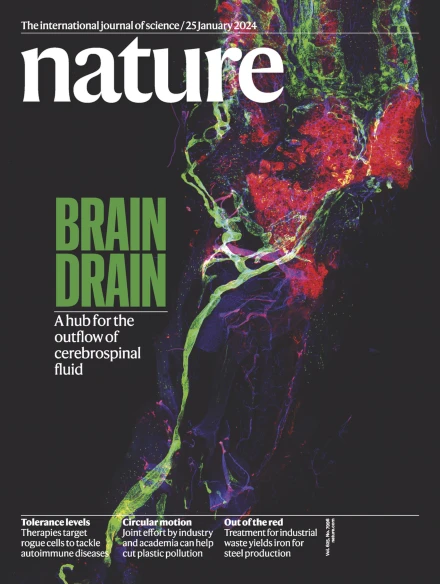Inhibitory specificity from a connectomic census of mouse visual cortex
IF 50.5
1区 综合性期刊
Q1 MULTIDISCIPLINARY SCIENCES
引用次数: 0
Abstract
Mammalian cortex features a vast diversity of neuronal cell types, each with characteristic anatomical, molecular and functional properties1. Synaptic connectivity shapes how each cell type participates in the cortical circuit, but mapping connectivity rules at the resolution of distinct cell types remains difficult. Here we used millimetre-scale volumetric electron microscopy2 to investigate the connectivity of all inhibitory neurons across a densely segmented neuronal population of 1,352 cells spanning all layers of mouse visual cortex, producing a wiring diagram of inhibition with more than 70,000 synapses. Inspired by classical neuroanatomy, we classified inhibitory neurons based on targeting of dendritic compartments and developed an excitatory neuron classification based on dendritic reconstructions with whole-cell maps of synaptic input. Single-cell connectivity showed a class of disinhibitory specialist that targets basket cells. Analysis of inhibitory connectivity onto excitatory neurons found widespread specificity, with many interneurons exhibiting differential targeting of spatially intermingled subpopulations. Inhibitory targeting was organized into ‘motif groups’, diverse sets of cells that collectively target both perisomatic and dendritic compartments of the same excitatory targets. Collectively, our analysis identified new organizing principles for cortical inhibition and will serve as a foundation for linking contemporary multimodal neuronal atlases with the cortical wiring diagram. Using volumetric electron microscopy, the authors map and analyze the structure of cortical inhibition with synaptic resolution across a column of visual cortex.


小鼠视觉皮层连接组普查的抑制性特异性
哺乳动物大脑皮层的神经细胞类型多种多样,每种类型都具有独特的解剖、分子和功能特性1。突触连通性决定了每种细胞类型参与皮层回路的方式,但在不同细胞类型的分辨率上绘制连通性规则仍然很困难。在这里,我们使用毫米尺度的体积电子显微镜2 研究了小鼠视觉皮层各层 1,352 个细胞组成的密集分割神经元群中所有抑制性神经元的连接性,绘制出了包含 70,000 多个突触的抑制线路图。受经典神经解剖学的启发,我们根据树突区的定位对抑制性神经元进行了分类,并根据树突重建和突触输入的全细胞图谱对兴奋性神经元进行了分类。单细胞连通性显示了一类以篮状细胞为目标的非抑制性专家。对兴奋神经元抑制性连接的分析发现了广泛的特异性,许多中间神经元对空间上相互混合的亚群表现出不同的靶向性。抑制性靶向被组织成 "图案组",即以相同兴奋性靶点的周围和树突区为靶点的不同细胞组。总之,我们的分析确定了大脑皮层抑制的新组织原则,并将为将当代多模态神经元图谱与大脑皮层布线图联系起来奠定基础。
本文章由计算机程序翻译,如有差异,请以英文原文为准。
求助全文
约1分钟内获得全文
求助全文
来源期刊

Nature
综合性期刊-综合性期刊
CiteScore
90.00
自引率
1.20%
发文量
3652
审稿时长
3 months
期刊介绍:
Nature is a prestigious international journal that publishes peer-reviewed research in various scientific and technological fields. The selection of articles is based on criteria such as originality, importance, interdisciplinary relevance, timeliness, accessibility, elegance, and surprising conclusions. In addition to showcasing significant scientific advances, Nature delivers rapid, authoritative, insightful news, and interpretation of current and upcoming trends impacting science, scientists, and the broader public. The journal serves a dual purpose: firstly, to promptly share noteworthy scientific advances and foster discussions among scientists, and secondly, to ensure the swift dissemination of scientific results globally, emphasizing their significance for knowledge, culture, and daily life.
 求助内容:
求助内容: 应助结果提醒方式:
应助结果提醒方式:


